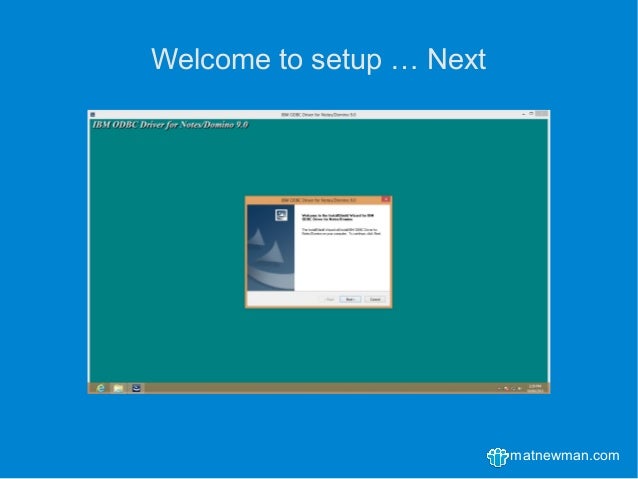I need to install Lotus NotesSQL Driver (current version is 8.5) onto a virtual machine running XP. Here's what's I've done so far: • I retrieved the file ( CZOWFEN.zip) from the IBM website. • I ran the exe. • I then went to My Computer-> Properties-> Advanced-> Environmental Settings-> System Variables-> Path and added '; c: notessql' so the ODBC Administrator could find Notes.ini (why the setup file didn't do this in the first place, i don't know). • I opened up the ODBC Administrator and tried to add a new System DSN to a Lotus DB. 'The setup routines for the Lotus Notes SQL Driver ( *.nsf) ODBC driver could not be loaded due to system error code 126' • I redownloaded and reinstalled the driver (making sure I had the latest version 8.5). • I checked the registry. Mbl4 full download torrent.
Palladium compendium of contemporary weapons pdf 2017. All the file paths appeared to be correct. • Per many, many similar cases on the internet, I tried several different variations of adding the various Lotus Notes folders to my PATH variables. I've done this setup on 5 different machines now with no problem. The only difference here is that this machine is virtual.
From my local machine I have been able to read NSF file using 32bit Lotus Notes ODBC driver. I have been unsuccessful to link the 32bit ODBC driver reference from SSMS based on the working 32bit ODBC references or the sample NSF file you provided. This white paper describes the process necessary to get started with NotesSQL. Specifically, this document covers the following points: what software is necessary to use NotesSQL, choosing your version of NotesSQL, OS Support Matrix, bitness, what IBM software should be installed locally for NotesSQL to use, troubleshooting, and additional NotesSQL resources.

On a recent project for a client, I was asked to create a database-driven site where one of the databases involved was a Lotus Notes database. Unlike other databases, such as Oracle and SQL Server, Notes doesn't have a relational database structure. This meant that I couldn't just create an ODBC connection from the ASP Web site I was creating and get access to the data that way. At least that's what I thought. NotesSQL While scouring the Lotus Notes Web site, among many others, to try and figure out how to accomplish my task, I came across a reference to an application called NotesSQL. NotesSQL is an ODBC driver for Lotus Notes databases, presenting them—at least at the basic level—in the same way as any relational database.
The NotesSQL ODBC driver is available for from the part of the Lotus Web site. There, you'll also find a Samples Kit with examples and detailed developer information. Configuring NotesSQL The NotesSQL application comes in two distinct components, both of which must be used in conjunction to get a working connection: • A thick client Admin and Management tool • The ODBC driver The first couple of topics that we need to address are contained in the thick client Admin tool. This tool is concerned with the management of the Notes servers that are available for a connection and the Notes IDs that can be used to connect to these servers. By default, the tool is installed into the Lotus Application/NotesSQL folder in the Programs menu.
Your first step is to register the Notes.ini file with the Admin tool so that all the servers in that file can potentially be accessed via an ODBC connection, as shown in Figure A. If you want only a limited number of servers within your environment to be accessible in this way, you can create a Notes.ini file containing only those server names. Figure B Notes ID This ensures that you're not using a live user account in which the password could change and that you're using the minimum access on the account to achieve your requirements—any more could potentially be a security risk. Add as many users as are required using the Add User button. When you've completed the list, click the Save List button.
The final step is to create an ODBC connection object, or DataSource Name (DSN), in the normal way; your application will use this object to connect to the Lotus Notes database, as shown in Figure C. You can use the ODBC connection object in your code in the same way as you would use an ODBC connection to any other database, such as SQL Server or Oracle. Figure C ODBC connection You must start by selecting the NotesSQL driver—the highlighted line in the dialog at the back of the screenshot. You are then presented with the dialog box in the foreground asking you to provide the details about the database this ODBC connection is designated for; the scanning of available Notes servers can take some time at this point. Upon selecting the Notes server that you want to connect to, you may be asked to provide a Notes password for the account that has been listed in the Admin tool. Remember that only those IDs listed in the Admin tool can be used in ODBC connections. Finally, add a name by which your code can refer to this ODBC connection and a short description about what it is used for.
Most Popular Articles
- Domiki Sostav Chisla V Predelah 10
- Download Best Viscosity Vpn Keygen Free Download And Torrent
- Swam Engine Keygen Crack
- Free Download Program Europe Final Countdown 1986 Rar
- Reshebnik Domashnee Chtenie Anglijskij Klub
- Contoh Soal Toefl Itp Dan Pembahasannya Pdf Merge
- Mupad 4 0 6 Keygen Serial
- Adobe Indesign Cs6 Portable
- Drivers For Camera Sensor Ov2722 Driver
- Nokia 108 Rm 944 Usb Driver